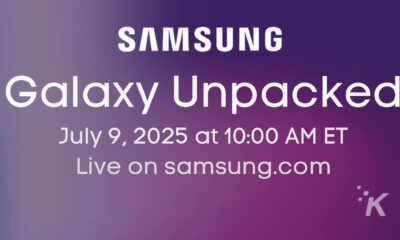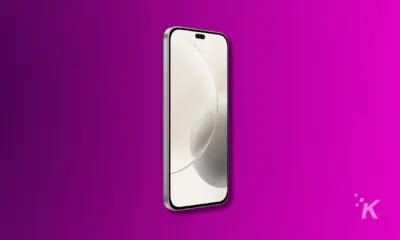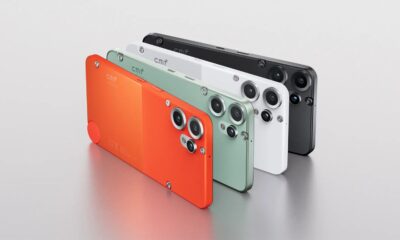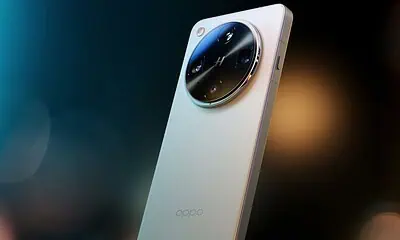Mobile
Review: Nothing Phone (2)
The Nothing Phone (2) is an excellent all-rounder and the best midrange Android you can get today.

Just a heads up, if you buy something through our links, we may get a small share of the sale. It’s one of the ways we keep the lights on here. Click here for more.
 Nothing Phone (2)
Nothing Phone (2)
- Eye-catching design with Glyph notification lights
- Solid overall camera performance
- Smooth software experience
- Above average battery life and fast charging
- Too slippery
- A bit too large
- No charger in the box
The quest to beat the iPhone as the default smartphone has been ongoing. There have been a lot of attempts to do that, with the result being some fantastic Android phones.
The Nothing Phone (2) is a grand entry into that competition, and it gets a lot of things right. It comes with its own set of unique features that sometimes border on gimmicks.
However, the phone is overall a great package and is a fantastic Android phone, especially if you want a well-rounded Android experience without spending $1,000 or more.
I used a Nothing Phone (2) in the 12/256GB configuration, sent over by the company, for a period of three months. It feels like the making of a new strong competitor to the best Android right now, if not the iPhone.
Price, specs, and availability
| Feature | Details |
|---|---|
| Display | 6.7-inch LTPO OLED (1-120Hz) FHD+ 1080 x 2412 pixels resolution 1000-nit max brightness, 1600-nit max HDR brightness |
| Chipset | Qualcomm Snapdragon 8 Plus Gen 1 |
| RAM and Storage | 8GB RAM + 128GB, 12GB RAM + 256/512GB, UFS 3.1 |
| Camera | 50MP (f/1.88) primary shooter with Sony IMX890 sensor, ƒ/1.88, OIS, EIS 50MP (f/2.2) ultra-wide camera with Samsung JN1 sensor, 114-degree FoV 32MP (f/2.45) selfie camera with a Sony IMX615 sensor |
| Battery | 4,700mAh 45W fast charging (0-100% in 55 min) 15W wireless charging 5W reverse wireless charging |
| Operating System | Nothing OS 2.0 based on Android 13 3 years of Android updates and 4 years of security updates |
| Wireless | 5G, Wi-Fi 6, BT 5.3, NFC |
| Other features | IP54 Fingerprint unlock Face Unlock Dual SIM Dual stereo speakers Glyph interface |
| Dimensions | 162.1 x 76.4 x 8.6 mm (6.38 x 3.01 x 0.34 in) |
| Weight | 201.2 g (7.09 oz) |
Nothing is going more global than before with the Nothing Phone (2). What that means is that it is available in the US, in addition to the UK, Europe, India, and a few other regions.
The Nothing Phone (2) pricing is as follows, available in Dark Grey and White:
- 8/128GB model: Currently $549/£499/€579, down from $599/£579/€679
- 12/256GB model: Currently $599/£549/€629, down from $699/£629/€729
- 12/512GB model: Currently $649/£599/€699, down from $799/£699/€849
The phone is available on Nothing’s online storefront across all regions. Additionally, the Nothing Phone (2) has also recently landed on Amazon in the US.
However, Amazon doesn’t have the 8GB variant, so you’ll have to pick between the 12GB versions with 256GB or 512GB storage, which cost $769 and $799 respectively.
Design: With or without Glyph
The Nothing Phone (2) design is pretty polarizing on paper, but it has been very well-received in reality. It’s similar to the Nothing Phone (1) but makes meaningful changes.
The functional design is an improvement here. The flat edges look unwelcoming but are rounded enough not to dig into your palms.
The rounded back glass is a huge help in hand feel, but it comes with a flaw that you need to be careful about — the Nothing Phone (2) is the most slippery phone I have ever used.
The phone is great in hand, but it starts to slide if you place it on any surface that’s not perfectly flat. I would not recommend using it without a case, even though the build quality is great.
For starters, the Dark Grey colorway doesn’t look as good as the Phone (1)’s black colorway, but it still looks great. I prefer the white option, but the contrast of the Glyph lighting is better on the Grey.
Speaking of which — the Glyph lights greatly add to the design. The phone stands out because of the lights, making the Nothing Phone (2) much less boring than its competitors.
The one design change I would have liked was for the phone to be small. A 6-inch screen would make this phone a lot more fun, even though smaller phones come with their own disadvantages.
Display
The Nothing Phone (2) has a 6.7-inch AMOLED screen with a 1080 x 2412 pixels resolution. On paper, the display is adequate for the size and price of the phone.
During my usage, the display was pretty great. It’s easy on the eyes, with pretty good-looking colors, and gets abundantly bright outdoors.
At the size, I would’ve liked to see a higher-resolution screen. However, the pixel density on this display is plenty good for most folks, and the overall quality is superb.
The display comes with a pre-applied screen protector. It peels away after a bit of use. During my usage, the display picked up quite a lot of minor scratches and scuffs as a result, although they’re not noticeable during use.
I recommend you get a tempered glass screen protector for this one, though, especially since the slippery nature of the phone is likely to land some blows to the display.
Nothing Phone (2) camera quality
This is a mid-range phone, and it punches above its weight in most areas. The camera performance is solid for the price.
The primary camera could be better, thanks to the Pixel A-series models and some iPhones and Samsung options at the price.
However, it’s no slouch. It reproduces details well, the color science is balanced, and the camera interface is simple and elegant.
What impressed me was the ultrawide camera, which is surprisingly consistent with the primary camera. It manages to keep a similar color science, and the loss of detail is minimal.
There’s no zoom camera on this phone, which is acceptable for the price. However, a zoom lens would have complemented this camera setup well, so it seems like a miss, regardless.
The selfie camera is also what you would expect. It takes crisp shots, maintains skin tone well, and has the face retouching option if you like it. It’s not groundbreaking, but you get good-quality shots with consistency.
Software
The software is a big talking point about Nothing’s phones and any smartphone company that tries to do something new.
Nothing OS seemed too gimmicky to me the first time I laid eyes on it. The dot matrix design was just not for me, and the overall theming seemed too pigeonholed in the same direction for me to like.
However, that’s not quite the case, and my first impression was entirely wrong. The software is immaculate, and you can opt out of the typical dot matrix-styled UI when setting up the device or later if you choose.
That leaves you with a very normal-looking Android skin, which is smooth as butter. I’m not kidding when I say that the Android experience felt more pristine than the Pixel 7 Pro, which was my daily driver for a while.
Overall, Nothing OS 2.0 keeps the best of Android. It does add some bells and whistles, but they’re largely easy to ignore. That makes this an excellent software experience.
Nothing phone (2) performance and battery life
The performance is excellent, too. The smoothness translates to real-world use, and the phone holds up quite fine in daily applications. It doesn’t have the latest hardware, but you get a pretty high-end chip.
The Snapdragon 8+ Gen 1 does quite well in the Nothing Phone (2). It’s not as good as the Snapdragon 8 Gen 2, but you can expect flagship-tier performance with a bit more heat.
I ran Geekbench 6 to get an idea of the performance on offer and the 3DMark Wild Life Extreme Stress Test to check sustained performance.
The Geekbench 6 benchmark result was just about right for the hardware.
| Geekbench 6 | Single-core score | Multi-core score |
| Nothing Phone (2) | 1728 | 4576 |
On the 3DMark Wild Life Extreme Stress Test, the Nothing Phone (2) didn’t do well. The stability figure was 71.6%, which isn’t great if you want to expect to do a lot of gaming on this phone over more extended periods.
| 3D Mark Wild Life Extreme Stress Test | Best loop score | Lowest loop score | Stability | Battery | Temperature | Frame rate |
| Nothing Phone (2) | 2693 | 1927 | 71.6% | 25% to 16% | 32° C to 44° C | 9 FPS to 20 FPS |
I did play Fortnite on the Nothing Phone (2) to see how it performed. At 100% 3D resolution, I could get 60fps at Epic quality and 90fps at Low quality settings.
It did have some frame drops but stuck to the frame rates for most of the playtime. I didn’t find any noticeable drop during my hour-long session.
The battery life of this phone is solid. I was able to get all-day usage, with about 10-15 percent left at the end of the day.
My usage included a lot of texting via Telegram, web browsing on Google Chrome, and a lot of Instagram and X/Twitter use.
My one complaint would be the lack of a charger in the box. I used a Nubia 65W charger, which charged the phone from 0-100% in under an hour at the 45W rate, which is pretty great. You also get 15W Qi wireless charging.
Alternative options to the Nothing Phone (2)
|
Primary Rating:
3.5
|
Primary Rating:
4.0
|
Primary Rating:
3.5
|
|
$799
|
$599
|
|
Should you buy the Nothing Phone (2)

The Nothing Phone (2) is an easy recommendation, especially at the currently lowered prices. The phone gets nearly everything right and establishes Nothing as a good phone maker to watch out for.
It’s a well-rounded package with decent hardware and great software, and despite some of the hiccups we have seen the company face, the phone itself is pretty great.
So, if you’re looking for a midrange phone that will service you well and has a bit of personality, the Nothing Phone (2) is the way to go.
Just make sure that the phone is well-protected because even though it has excellent build quality, it is still pretty slippery, and a little extra protection never hurts anyone.
 Nothing Phone (2)
Nothing Phone (2)
Have any thoughts on this? Drop us a line below in the comments, or carry the discussion to our Twitter or Facebook.
Editors’ Recommendations:
- Review: OnePlus Open
- Review: Roccat Kone Air Mouse
- Review Roundup: Google Pixel 8 and Pixel 8 Pro
- Review Roundup: iPhone 15 & iPhone 15 Plus – worth the hype?









































